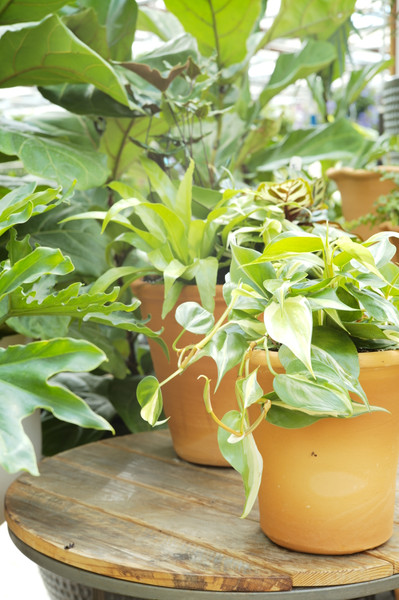Cool Weather Outside, Bring Houseplants Inside
Posted by Jessie Jacobson on Sep 15th 2024
Cool Weather Outside, Bring Houseplants Inside
Summer has made way for a gorgeous fall season, and we all know what comes next. Winter! As we make our way towards the shortest days of the year, it’s time to start bringing indoor plants back inside for the season.
Let's get started.
Before you haul plants indoors, make sure they’re safe for your furry friends. Check out our Pet Friendly Plants Blog or aspca.org for pet friendly options. For your viewing pleasure, a Pet Safe Plants Video!
Wash and wipe
Leave the grime and grunge outside. Start by wiping larger leaves with a damp cloth – tops and bottoms. You can even hose them down on a nice warm day. To clean cacti and succulents, use an air duster or a small paintbrush.
Treat for pests
Outdoor plants can become home to ants, pill bugs, or other indoor plant specific pests such as mealy bugs and spider mites. Spray stems, tops and bottoms of leaves with insecticidal soap to treat for unwanted creepy crawlies.
Repot, if needed
If your soil is compacted and your plant is root bound, it's time to repot. Choose a container that’s at least one or two sizes up from the current one. Use fresh potting soil, and make sure your container has a drainage hole. We recommend planting in lightweight plastic liner pots or grower pots. This makes plants easy to drop into decorative containers and easy to pull back out again for pest control, repotting, or watering. We have a Repotting Blog for your convinience Also, check out these re-potting videos for more information! Re-Potting a Fiddle Leaf Fig, Using a Drop-In Planter with Houseplants, and Repotting a Monstera.
Shine on!
Leaf Shine is the botox of the plant world. Use it to shine up and remove hard water stains from your leaves. Do read the label as some plants, including dracaena, ferns and most succulents don’t fare well with this product. We the Wild's Protect Spray shines and protects from pests as its active ingredient is neem oil.
Pull back on the feed
Go for half strength on fertilization and feed less often. We love Schultz All Purpose Liquid Plant Food. If you would like to go the organic route, use We the Wild's Grow Concentrate. Also check out our Fertilizing Indoor Plants Blog!
Foliage for the Win
If you used foliage and tropical plants in your summer container designs, don’t be afraid to bring them in. Just make sure you are placing them in ample light indoors. Indoor and outdoor light are very different. Plants that loved it in the shade outdoors may need bright light indoors. Basic light classifications are low, medium, and bright. Check out our indoor light guide for proper plant placement. And make sure to take a look at our Learn About Light Coloring Page!
Flowers May Fade
Flowering tropical plants are a bit more challenging to overwinter indoors. They require A TON of bright light, so a sunny, south facing window is best. The ideal temperature for most flowering/tropical plants when not actively growing is about 65 degrees. Don’t be tempted to jack up the heat just for the plants, as warmer air temperatures can lead to leggy growth and insect problems. Like all indoor plants, keep plants like hibiscus, jasmine, and alocasia away from drafty windows and heat vents. Increase humidity around the plant by grouping plants, misting, or a humidifier.
If you'd like to let your plants simply go dormant, give them a big pruning, and cut them waaay back. Let them rest in a cool place (40 to 50 degrees F) with little or no light—their leaves will gradually yellow and drop. Water sparingly – about twice per month. Move to bright light in March of next year. At that time, start a regular watering routine, get back to fertilizing, and watch them grow! Growth and blooms on overwintered tropicals will appear later in the spring than a grab-and-go containers from the garden center.
There you go! You can do this. Love your plants and they will love you back!

